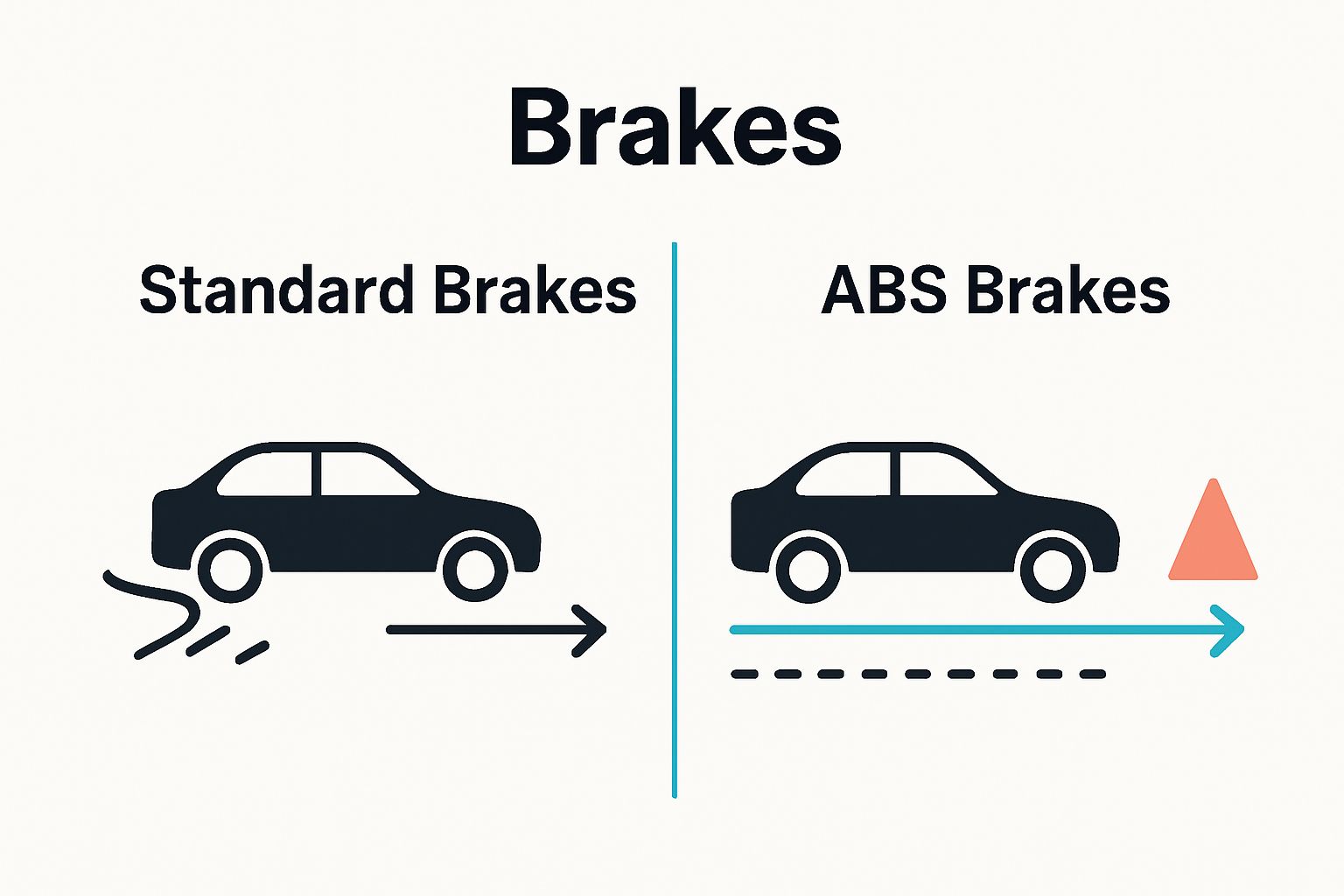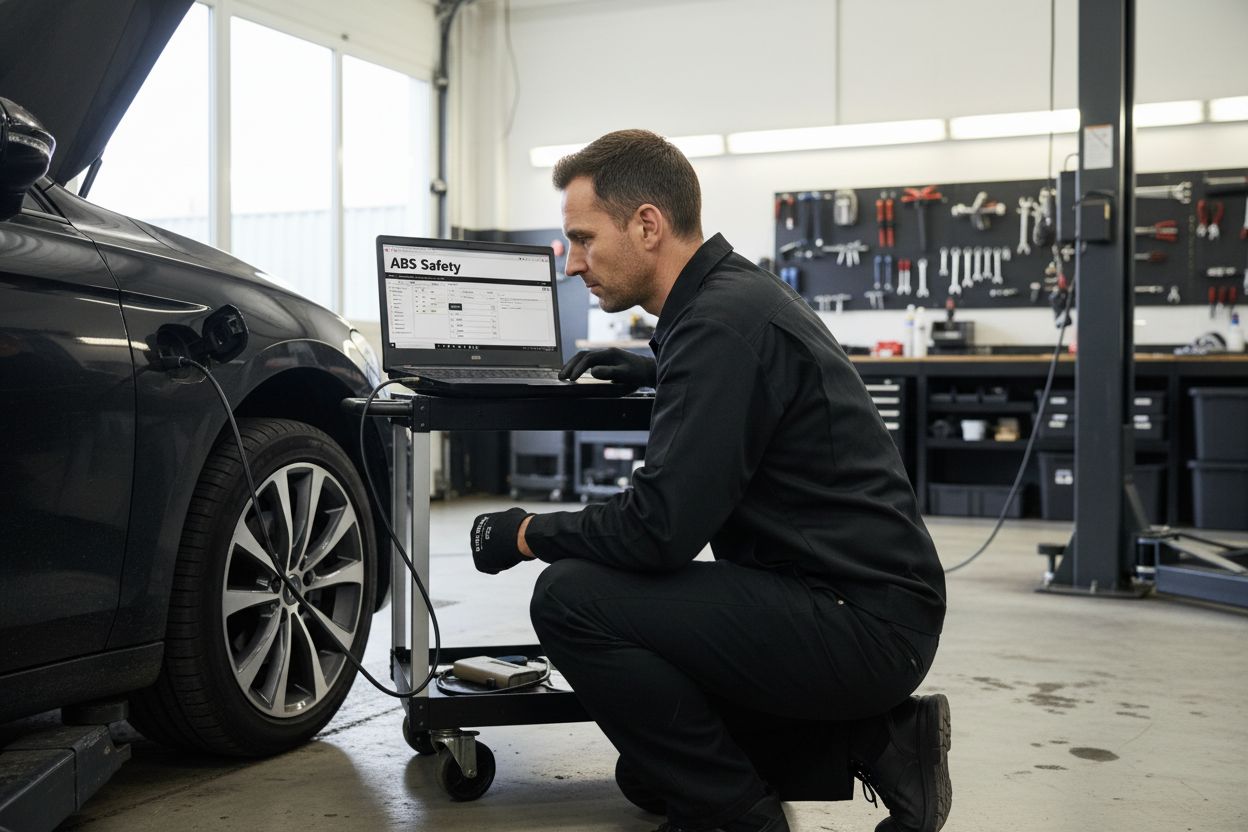Understanding ABS Brakes Explained for Car Buyers
October 11, 2025
ABS brakes have changed what it means to stop safely in a car. Most people know they help you avoid skidding, but what surprises many is just how fast they react. These systems can adjust brake pressure in milliseconds, far quicker than any human driver could ever hope to manage. That split-second difference does not just help you stop, it can save your life when it matters most.
Table of Contents
- What Are Abs Brakes And How Do They Function?
- The Importance Of Abs Brakes In Modern Vehicles
- How Abs Technology Enhances Vehicle Safety
- Key Concepts Behind Anti-Lock Braking Systems
Quick Summary
| Takeaway | Explanation |
|---|---|
| ABS prevents wheel lockup. | Anti-lock braking systems monitor wheel rotation to avoid lockup during sudden braking, enhancing control. |
| Improves steering during hard stops. | ABS allows drivers to steer while braking, reducing loss of control and collision risks. |
| Potentially lowers insurance costs. | Vehicles with ABS often qualify for lower insurance premiums, adding financial benefits to safety. |
| Enhanced performance on slippery surfaces. | ABS provides better stopping distances and navigation around obstacles on wet or uneven roads. |
| Integral to modern vehicle safety. | ABS combines with other safety technologies to optimize vehicle control and minimize accident risks. |
What Are ABS Brakes and How Do They Function?
Anti-lock braking systems (ABS) represent a critical automotive safety technology designed to prevent wheel lockup during emergency braking situations. Modern vehicles equipped with ABS provide drivers enhanced control and stability when stopping quickly, especially on slippery or uneven road surfaces.
The Core Mechanism of ABS
At its fundamental level, ABS works by monitoring wheel rotation and automatically modulating brake pressure to prevent skidding. Safety researchers from the National Highway Traffic Safety Administration confirm that the system uses specialized wheel speed sensors to detect potential wheel lockup moments before they occur.
The system operates through a sophisticated electronic control mechanism that performs incredible calculations in milliseconds:
To help readers understand the mechanisms and function of ABS, this table breaks down the main components and their roles as described in the article.
| ABS Component | Description |
|---|---|
| Wheel Speed Sensors | Continuously monitor each wheel’s rotation speed to detect the risk of wheel lockup |
| Electronic Control Unit | Processes sensor data in milliseconds to identify when to engage the ABS |
| Hydraulic Modulator | Adjusts and controls brake pressure to individual wheels automatically |
| Brake Lines | Carry hydraulic fluid whose pressure is regulated by ABS during emergency stops |
| Signal Processing | Sophisticated algorithms evaluate sensor data for real-time intervention |
- Continuously monitors wheel rotation speed
- Detects sudden deceleration indicating potential skid
- Rapidly adjusts brake pressure to individual wheels
- Prevents complete wheel stoppage while maintaining maximum braking force
Why ABS Makes Driving Safer
Traditional braking systems could cause wheels to lock completely during hard stops, leading to potential loss of vehicle control. ABS solves this problem by “pumping” the brakes much faster than a human driver could manually. This means drivers maintain steering ability during emergency braking scenarios, significantly reducing accident risks.

Modern ABS technology enables drivers to:
- Maintain directional control during sudden stops
- Reduce stopping distances on varied road surfaces
- Provide more predictable braking performance
- Minimize the risk of skidding or spinning
By preventing wheel lockup and allowing drivers to steer while braking hard, ABS represents a quantum leap in automotive safety technology that has saved countless lives since its widespread adoption.
The Importance of ABS Brakes in Modern Vehicles
ABS brakes have transformed automotive safety, representing a critical technological advancement that significantly reduces accident risks for drivers across various road conditions. Transportation safety experts from the Insurance Institute for Highway Safety consistently highlight the life-saving potential of advanced braking technologies.
Enhanced Vehicle Control and Safety
The primary significance of ABS brakes lies in their ability to provide drivers unprecedented control during emergency stopping situations. Unlike traditional braking systems that can cause wheels to lock and vehicles to skid uncontrollably, ABS ensures drivers can:
- Maintain steering capabilities during hard braking
- Reduce potential collision risks
- Navigate around unexpected obstacles
- Stop more precisely on slippery surfaces
Economic and Insurance Implications
Beyond safety benefits, ABS brakes can have meaningful financial implications for vehicle owners. Many insurance companies offer reduced premiums for vehicles equipped with advanced safety technologies like ABS. This means drivers not only protect themselves but potentially save money on insurance costs.
Key economic advantages include:
The following table organizes the major safety and economic benefits of ABS brakes as highlighted in the article, making it easier to scan for both direct and indirect advantages.
| Benefit | How ABS Provides This Advantage |
|---|---|
| Enhanced Steering Control | Allows steering during hard stops by preventing wheel lockup |
| Reduced Accident Risk | Minimizes skidding and helps navigate around obstacles during emergencies |
| Improved Stopping on Slippery Roads | Maintains optimal braking force on wet or uneven surfaces |
| Lower Insurance Costs | Vehicles with ABS often qualify for premium reductions with many insurance providers |
| Decreased Repair Expenses | Lower risk of accident-related repairs due to improved control |
| Higher Resale Value | ABS is a sought-after safety feature that can increase a car’s value |
- Potential insurance premium reductions
- Lower likelihood of accident-related repair costs
- Increased vehicle resale value
- Improved overall driving confidence
Technological Evolution of Braking Systems
Modern ABS represents more than a standalone feature it integrates seamlessly with other advanced driver assistance systems. Learn more about vehicle safety technologies on our comprehensive guide that explores how interconnected safety systems work together to protect drivers.
As automotive technology continues advancing, ABS remains a foundational element of vehicle safety design. Its ability to provide split-second intervention during critical moments demonstrates how engineering innovations can directly translate into saving lives on the road.
How ABS Technology Enhances Vehicle Safety
ABS technology represents a quantum leap in automotive safety, transforming how drivers respond to critical braking scenarios. Safety researchers from the National Highway Traffic Safety Administration confirm that ABS significantly reduces fatal crash involvement rates across various vehicle types.
Preventing Wheel Lockup and Maintaining Control
The core safety enhancement of ABS lies in its ability to prevent wheels from completely stopping during hard braking. When a driver applies sudden, intense brake pressure, traditional braking systems could cause wheels to lock, leading to:
- Loss of steering control
- Increased skidding risk
- Potential vehicle spin
- Extended stopping distances
ABS counteracts these dangerous scenarios by rapidly modulating brake pressure. This means the wheels continue rotating, allowing drivers to steer and navigate around obstacles even during emergency stops.
Real World Safety Performance
Statistical evidence underscores the life-saving potential of ABS technology. Research indicates that ABS can reduce accident risks by providing drivers critical advantages during challenging driving conditions such as:
- Wet or slippery road surfaces
- Sudden obstacle avoidance scenarios
- Uneven terrain or gravel roads
- High-speed emergency braking situations
Explore our comprehensive guide on vehicle safety technologies to understand how ABS integrates with other advanced safety systems.
By enabling more precise and controlled stopping, ABS transforms vehicle safety from a passive protection system to an active driver assistance technology. Its split-second electronic interventions bridge the gap between human reaction time and optimal braking performance, ultimately saving lives on roadways across the world.

Key Concepts Behind Anti-Lock Braking Systems
Anti-lock braking systems represent a sophisticated electronic safety mechanism designed to optimize vehicle stopping performance. Automotive engineering experts from SAE International highlight the complex technological principles that enable these systems to perform critical interventions during emergency braking scenarios.
Electronic Wheel Speed Monitoring
At the heart of ABS technology lies an intricate network of electronic sensors strategically placed at each wheel. These sensors continuously measure rotational speed and detect minute variations that could indicate potential wheel lockup. The system performs this monitoring in milliseconds, allowing for instantaneous brake pressure adjustments.
Key components of wheel speed monitoring include:
- High-precision rotational speed sensors
- Electronic control units (ECU)
- Hydraulic brake pressure modulators
- Rapid signal processing algorithms
Hydraulic Brake Pressure Modulation
When the ABS detects potential wheel lockup, it activates a complex hydraulic mechanism that precisely controls brake fluid pressure. This process involves rapidly:
- Reducing brake pressure to prevent complete wheel stoppage
- Maintaining minimal braking force
- Rapidly reapplying brake pressure
- Repeating this cycle multiple times per second
Read our comprehensive guide on vehicle safety technologies to understand how ABS integrates with other advanced driver assistance systems.
The genius of ABS lies in its ability to perform these intricate interventions faster than human reflexes, transforming vehicle braking from a potentially dangerous mechanical process to a sophisticated electronic safety mechanism. By understanding these key technological concepts, drivers can appreciate the remarkable engineering that helps protect them on the road.
Go Further With ABS Confidence on ReVroom
If understanding ABS brakes has you searching for safer, more dependable vehicles, you deserve a car-buying experience that matches your standards for control and transparency. Too often, car buyers worry about hidden histories and miss out on great deals because the facts are hard to uncover. At ReVroom, we make sure you see the full picture with detailed accident history info and visual proof of every rebuilt title car’s journey back to the road. You learn what ABS means. We show you where the true value lives.

Ready to apply your knowledge and find a rebuilt title car with the safety features you want? Visit ReVroom to explore listings packed with essential information, clear photos and the full story. Skip the guesswork and get the transparency you expect. Take a step closer to your next car by checking out our home page. Choose insight. Choose safety. Choose to go further—your new ride is waiting.
Frequently Asked Questions
What are the main benefits of ABS brakes for car buyers?
ABS brakes provide enhanced control during emergency stops, preventing wheel lockup and allowing drivers to steer while braking. This technology can significantly reduce the risk of skidding or loss of control, making it a crucial safety feature to look for in a vehicle.
How does ABS improve stopping distance on slippery surfaces?
ABS helps shorten stopping distances by preventing wheels from locking during hard braking, especially on wet or icy roads. This means drivers can stop more effectively while maintaining steering control, reducing the likelihood of sliding off the road or into obstacles.
Are vehicles with ABS brakes safer than those without?
Yes, vehicles equipped with ABS brakes generally offer greater safety compared to those without because they help prevent loss of control during emergency braking situations. Consider this feature a priority when evaluating vehicles for its potential to save lives and prevent accidents.
Do ABS brakes reduce insurance premiums for car owners?
Many insurance companies offer lower premiums for vehicles with advanced safety features like ABS. Check with your insurance provider to understand how having ABS can contribute to potential savings in your insurance costs.
How can I tell if a vehicle is equipped with ABS brakes?
Look for an ABS indicator light on the vehicle’s dashboard, which illuminates when you start the engine. Additionally, you can review the vehicle specifications or ask the seller to confirm if the car has an ABS system installed.
What should I do if the ABS warning light comes on while driving?
If the ABS warning light activates while driving, it indicates a potential issue with the ABS system. Safely pull over to a location and consult a mechanic to have the braking system inspected, ensuring your vehicle remains safe for operation.
